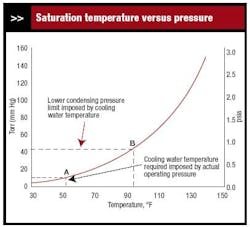Cooling towers play a crucial role at many plants. Metals towers are often chosen because of their low initial cost and when large capacity is necessary. However, plastic towers can offer economic and operational advantages, and now come in modular designs suitable for bigger loads.
Metal towers frequently demand extensive maintenance. A single cut through the galvanizing or other protective coating to expose bare steel can severely compromise protection and lead to significant corrosion. Mineral deposits and scale (Figure 1) can build up.
Figure 1. Scale can deposit on metal surfaces (left), but not on engineered plastics, where removal only requires a washdown.
So, over time, such towers become increasingly thin-skinned and inefficient, and can prompt unscheduled process disruptions. Chronic “leakers” can cause secondary damage, while outdated tower fans and motors often consume more energy than necessary. All of this can add up to a “money pit.”
“We were spending between $5,000 and $10,000 a year on cooling tower repairs — patching metal, putting in rubber seals and gasketing. In other words, ‘Band-Aid’ fixes just to keep the tower from leaking,” says Marvin Richer, president of Brock Equipment Co., a Crystal Lake, Ill., manufacturer of hydraulic pumps and related tools. “My issues were really simple,” notes Glenn Burroughs, a test engineer with a major oilfield services firm. “I’m very busy running tests and don’t have the time or personnel for cooling tower maintenance, so I went looking for a cooling tower that I was not going to have to do any maintenance on.”
Minimizing maintenance
Replacing towers is time-consuming and expensive, as is the installation of additional towers to increase cooling capacity. “Given our choices, we were most likely going to install a new tower similar to the old one,” Richer says. “But first I wanted to look into a new plastic type of cooling tower that was said to be more reliable and require less maintenance than the old-fashioned metal-lined models.”
What Richer was looking for has become a new prescription for replacing ailing cooling towers or adding capacity: engineered molded-plastic cooling towers. Just as advanced plastics have supplanted metal in many high-tech and industrial applications, plastics also offer a remarkably comprehensive solution to the chronic deficiencies of metal-skinned cooling towers.
The latest engineered-plastic cooling towers also ease installation, especially on rooftops (Figure 2), because a lightweight plastic shell may weigh up to 40% less than a steel tower while being five-to-10 times thicker. Some models incorporate innovative I-beam “pockets” to reinforce the tower bottom so that they can be easily mounted on standard I-beams or imperfect pads.
Figure 2. The light weight of a plastic tower may make such an installation possible and allow better access to the wind.
Additionally, some engineered-plastic towers feature an induced-draft counter-flow design that provides improved cooling efficiency and thus a smaller footprint, which can be important where there are locating constraints.
Greater cooling capacities and improved structures aren’t the only innovations. Some manufacturers are pioneering direct-drive fan systems that require minimal maintenance because of fewer moving parts: no gear reducers, belts, couplings, additional shafts or extra bearings.
With Brock Equipment, it quickly became clear that the company was “throwing good money after bad” by continually spending time and cash on its old, deteriorating galvanized-metal-lined tower installed in 1950. “As the tower got older, not only did we have ongoing leak problems, we started to have a structural problem,” Richer explains. “Water is pretty heavy and the tanks that hold the water on the bottom were getting heavier and heavier as we added more and more materials to fix the leaks. All that weight was beginning to bend the structural members that held the cooling tank together.”
Richer appreciated the potential of plastic. “We thought this might be a better technology than galvanized steel,” he notes. “The installation of our new tower took a total of four days… In fact, the installation of the tower was a one-day deal, but some pipes coming into the building had to be reconfigured so that took extra time,” he says. “If you are familiar with plastics, you know that engineered plastic used to form Delta towers is very tough and this has proved to be the case. The new cooling tower has been trouble-free for over three years. We still have normal maintenance. We clean in the spring and make sure the filters are clean. But there has been no repair work on the tower, no leaks at all.”
Olin Brass in East Alton, Ill., is another company pleased with its switch to plastic. “The decision was to replace our galvanized-steel cooling towers with the newer molded-plastic cooling tower design,” explains Matt Niemeyer, staff engineer. “They were 10- or 12- years-old and had already rusted completely through in several areas. All of that was in terrible shape and had to be repaired several times.”
“The cooling tower was a straight splash bar design,” continues Niemeyer, “and because the tower would fill with all the heavy junk that collected as the dirty water was cooled, the grid and fill within the tower eventually collapsed.” Last year Olin changed its contact cooling method to a closed-loop clean water configuration.
“We converted to a Delta Cooling Tower to overcome the inefficient open-loop system that had collapsed the fill under the weight of dirt and scale in the water,” he notes. “The closed-loop clean water system made it possible to go with the different cooling tower design. Instead of having a splash bar fill, which is about the best you can do for dirty water, we were able to go with a PVC film fill — what’s in the Delta tower. That also allowed us to change from a crossflow tower to a counterflow tower, which gives us greater cooling capacity for its size. We had a limited footprint for the tower, so that has worked out great.”
“The new plastic tower is corrosion proof, and so we don’t have to worry about rust,” Niemeyer adds. “It was also the most economical price, and we were very pleased about that.”
Environmental testing of equipment for oil drilling and production operations poses special demands, notes test engineer Burroughs. “I needed a cooling tower with water-distribution power that is far from normal operating conditions… Secondly, I hate doing maintenance.” The cooling tower supports electrodynamic shakers that check whether the equipment is tough enough. “These shakers emit a great deal of heat and they’re cooled by a closed distilled water system because distilled water doesn’t conduct electricity,” he explains. “Once heated, the distilled water flows through heat exchangers that are cooled by a chill water loop. A three–year-old, 100-ton Delta plastic tower is on the other end of the chill water loop. Another similar unit was also used to reject the heat created by two 1,000-hp drilling mud pumps. It has been working fine for over 13 years.”
Increasing size and efficiency
In the past, plastic cooling towers were considered “too small” for many plants and galvanized-steel cooling towers were generally chosen for packaged applications above 250 tons. However, factory-assembled plastic towers such as Delta’s TM Series can now be combined to provide up to 2,000 cooling tons in a single modularized unit. The modular design makes it easy to provide an extra margin of capacity to handle heat-load or outflow changes, or to upgrade to meet future requirements.
The modular design also introduces new flexibility for conserving valuable real estate. By molding towers in a rectangular shape, some manufacturers enable users to cluster cooling towers in a group that occupies a much smaller footprint. “With the new Delta system we actually got more cooling with less tower,” says Richer. “Our old 45 × 20 ×18 metal cooling tower was replaced by a lightweight plastic model that is only half that size, yet has slightly greater cooling capacity.”
While the cost of electricity to drive cooling tower fans may seem minor compared to process costs, it adds up. Direct-drive motors are more efficient and hence deliver substantial energy savings as well as more horsepower. “The two motors installed on the old tower were each 40-hp, 3-phase, 480-volts. On the new tower there are four 10-hp motors,” Richer says. “So we now have only half the power requirement. Plus the new motors are more efficient than the old ones. We have not measured the energy saving, but it’s there.”
In some cases an engineered-plastic cooling tower allows users to completely re-vamp the technologies supporting their cooling systems, achieving greater productivity and savings in the process.
“The molded-plastic cooling tower is the only way for us to go, as I was able to eliminate double cooling — which was the case when we had metal cooling towers cooling down chillers for the process water,” says Doug Henderson, project engineer for Cerro Wire & Cable, Hartselle, Ala. “We switched over to plastic cooling towers and they give us enough cold water that we can do the job without any problems and we don’t waste the energy.” Today Cerro Wire & Cable uses four 200–ton Delta cooling towers for four different process areas. Three go through heat exchangers to cool process water, while the fourth cools an open loop that runs through water troughs to cool wire as it is encased with plastic.
Bright future
As engineers learn to recognize that plastic cooling towers aren’t just for small applications, these towers will continue to expand into areas once dominated by towers made of metal, concrete and wood.
For more information on Delta cooling towers go to
Dave Jurgensen is national sales manager for Delta Cooling Towers, Inc., Rockaway, N.J.; e-mail him at [email protected].
.

